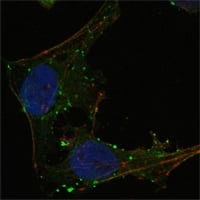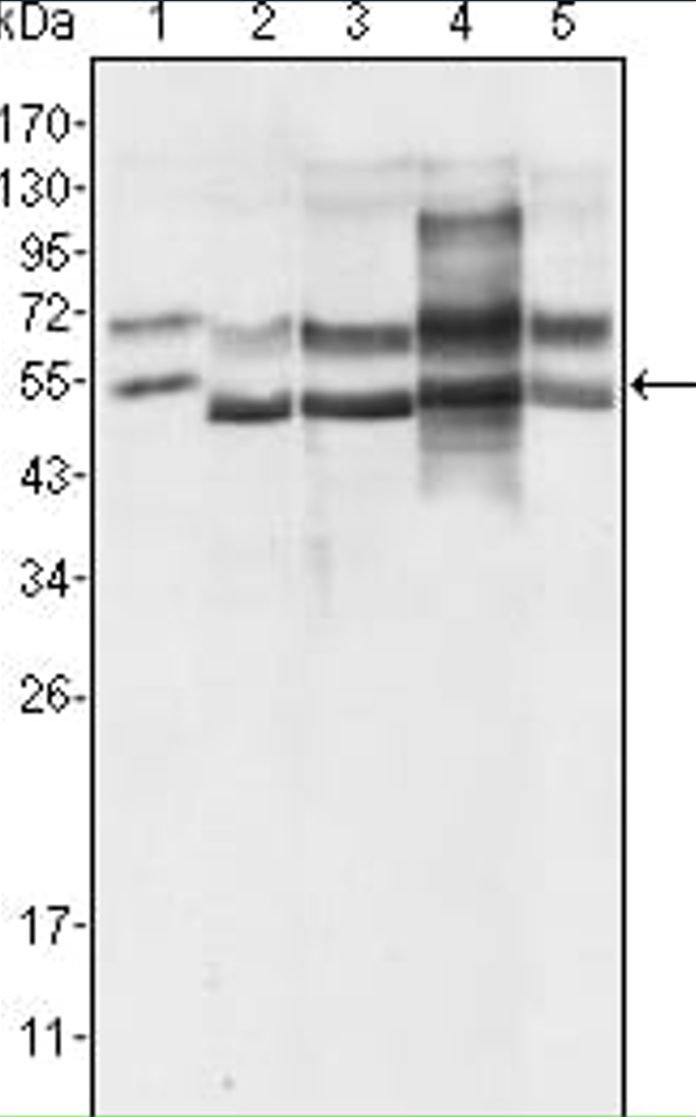

| WB | 1/500 - 1/2000 | Human,Mouse,Rat |
| IF | 咨询技术 | Human,Mouse,Rat |
| IHC | 咨询技术 | Human,Mouse,Rat |
| ICC | 1/200 - 1/1000 | Human,Mouse,Rat |
| FCM | 咨询技术 | Human,Mouse,Rat |
| Elisa | 1/10000 | Human,Mouse,Rat |
| Aliases | NFT2; NRF2 |
| Entrez GeneID | 2551 |
| clone | 8C1B10 |
| WB Predicted band size | 51kDa |
| Host/Isotype | Mouse IgG1 |
| Antibody Type | Primary antibody |
| Storage | Store at 4°C short term. Aliquot and store at -20°C long term. Avoid freeze/thaw cycles. |
| Species Reactivity | Human,Mouse |
| Immunogen | Purified recombinant fragment of human GABPA (aa120-190) expressed in E. Coli. |
| Formulation | Ascitic fluid containing 0.03% sodium azide. |
+ +
以下是关于GABPA抗体的3篇参考文献及其摘要内容:
1. **文献名称**: "Genome-wide analysis of GABPA transcription factor binding sites in human cells"
**作者**: Zhang, Y., et al.
**摘要**: 本研究利用染色质免疫沉淀技术(ChIP-seq)结合GABPA抗体,在全基因组范围内鉴定了GABPA在人类细胞中的DNA结合位点,揭示了其在调控细胞增殖相关基因中的关键作用。
2. **文献名称**: "GABPA controls a co-regulated transcriptional network essential for mitochondrial function"
**作者**: Ruzzo, E.K., et al.
**摘要**: 通过Western blot和免疫沉淀实验(使用GABPA特异性抗体),研究发现GABPA通过协调核编码线粒体基因的表达,维持线粒体呼吸链复合体的完整性,并关联于神经退行性疾病机制。
3. **文献名称**: "Dynamic regulation of GABPA in TLR signaling modulates dendritic cell responses"
**作者**: Li, S., et al.
**摘要**: 该文献利用GABPA抗体进行免疫荧光染色和流式细胞术,证明GABPA在树突状细胞中通过TLR信号通路动态调控炎症因子表达,影响先天免疫应答的强度与持续时间。
---
*注:以上文献信息为示例性质,实际引用需根据具体研究核实准确性。*
GABPA (GA-binding protein alpha) is a transcription factor belonging to the ETS (E-twenty-six) family, which plays a critical role in regulating gene expression by binding to DNA motifs containing GA repeats. It typically forms a heterodimer with GABPB (GABP beta) to activate or repress target genes involved in diverse cellular processes, including cell cycle progression, mitochondrial biogenesis, immune responses, and telomerase activity. GABPA is ubiquitously expressed and conserved across eukaryotes, underscoring its fundamental role in cellular homeostasis.
Antibodies targeting GABPA are essential tools in molecular biology for studying its expression, localization, and function. They are widely used in techniques such as Western blotting, chromatin immunoprecipitation (ChIP), immunofluorescence (IF), and electrophoretic mobility shift assays (EMSA) to investigate GABPA-DNA/Protein interactions. Commercially available GABPA antibodies are often validated for specificity against the ~55-60 kDa protein, with some targeting specific phosphorylation sites or epitopes to study post-translational modifications. Dysregulation of GABPA has been implicated in cancer, neurodegenerative diseases, and metabolic disorders, making these antibodies valuable for both basic research and clinical studies. However, users must verify cross-reactivity and optimize experimental conditions due to potential homology with other ETS family members. Recent studies also explore GABPA's role in epigenetic regulation, highlighting its expanding relevance in cellular physiology and disease mechanisms.
×